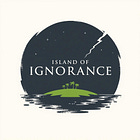"The most merciful thing in the world, I think, is the inability of the human mind to correlate all its contents. We live on a placid island of ignorance in the midst of black seas of infinity, and it was not meant that we should voyage far. The sciences, each straining in its own direction, have hitherto harmed us little; but some day the piecing together of dissociated knowledge will open up such terrifying vistas of reality, and of our frightful position therein, that we shall either go mad from the revelation or flee from the deadly light into the peace and safety of a new dark age." -H. P. Lovecraft
Welcome to the madness in the dark age of Island of Ignorance.
The Cartographer’s Toolkit: Methods for Building Knowledge Maps in the Age of Manipulation
Introduction: The Need for Knowledge Maps
In a world inundated with information, clarity is both a luxury and a necessity. The sheer volume of data, coupled with sophisticated attempts to manipulate perception, has created a landscape where individuals often struggle to discern reality from distortion. This complexity demands a practical solution: knowledge mapping.
Knowledge maps—visual or conceptual tools for organizing and interpreting information—are essential for navigating the modern world. They help distill complexity, highlight relationships, and guide decisions. However, knowledge maps are not mirrors of reality; they are selective constructions that prioritize certain details while omitting others. Their power lies in their purpose, and different methods offer diverse ways to construct these maps effectively.
This article introduces a toolkit of knowledge mapping techniques to empower readers to build their own adaptive and robust maps. Each section links to a longer article that explores that topic in more detail. This acknowledges that no single method can capture the entirety of a territory but argues that combining approaches offers a richer, more useful understanding. By mastering these tools, individuals can reclaim autonomy in a world increasingly designed to manipulate their perceptions.
Part 1: The Knowledge Mapping Toolkit
1. Simplified Narratives
Simplified narratives condense complex realities into coherent and digestible stories. They are invaluable for communicating key ideas and guiding decisions when time and clarity are critical. Political speeches, educational content, and media coverage often rely on this method.
Utility: Simplified narratives offer clarity and accessibility, making them ideal for rallying collective action or introducing concepts to new audiences.
Limitations: Their strength is also their weakness. Simplified narratives can oversimplify, omit critical nuances, or be weaponized for manipulation.
Application: To use this tool effectively, focus on maintaining integrity in your narrative while being conscious of its inherent biases. Use simplified narratives as starting points, not final conclusions.
2. Non-Simplified Narratives
In contrast, non-simplified narratives embrace the full complexity of their subject matter. These narratives delve into the layers of meaning, conflict, and perspective that define reality.
Utility: By capturing nuance and multiplicity, non-simplified narratives are ideal for deep analysis and understanding systems of interconnected elements.
Challenges: They require more time and effort to construct and can be difficult to communicate effectively.
Application: Use non-simplified narratives to map fields like history, sociology, or complex social movements. They are particularly valuable when uncovering hidden patterns or power dynamics.
3. Categories
Categories organize information into structured hierarchies or taxonomies. This method excels in environments requiring clarity and precision, such as libraries or academic research.
Utility: Categories are efficient for managing large datasets and providing clear reference points.
Limitations: They can become rigid and struggle to adapt to dynamic or fluid contexts.
Application: Use categories to build foundational knowledge maps, but remain open to revising them as new data emerges or contexts shift.
4. Patterns
Patterns focus on identifying recurring motifs, relationships, or behaviors across data points. This method highlights underlying structures that might otherwise go unnoticed.
Utility: Patterns reveal systemic dynamics, making them powerful tools for predictive modeling and innovation.
Limitations: They risk overgeneralization or overlooking anomalies.
Application: Look for patterns in trends, behaviors, or historical trajectories to inform decisions and anticipate future developments.
5. Systems Theory and Complex Adaptive Systems (CAS)
Systems theory and CAS provide a framework for mapping interconnected systems where feedback loops and emergent behaviors are central. These methods excel in dynamic environments where change is constant.
Utility: They offer deep insights into how changes in one part of a system can ripple through the whole.
Application: Use systems theory to understand organizational dynamics, ecological interactions, or market systems. Apply CAS to explore adaptive behaviors and emergent properties in evolving systems.
6. Genealogy and CAS
Genealogy, influenced by thinkers like Nietzsche and Foucault, examines the historical evolution of concepts and systems. When combined with CAS, it reveals how power and knowledge interact over time.
Utility: This method uncovers the origins and transformations of value systems, offering critical insights into entrenched ideologies.
Application: Use this approach to analyze socio-political shifts, cultural phenomena, or institutional change.
Part 2: The Adaptive Context—The KVDA Loop
To understand how knowledge maps operate in real-world contexts, it is essential to consider the KVDA loop: Knowledge → Values → Decisions → Actions. This iterative process highlights the dynamic interplay between knowledge and behavior:
Knowledge shapes what we perceive as true.
Values filter and prioritize that knowledge.
Decisions emerge from the interaction of knowledge and values.
Actions feedback into the system, reshaping both knowledge and values.
Mapping the KVDA loop helps identify the adaptive nature of human and organizational systems, showing how knowledge maps are continuously refined through experience and feedback.
Part 3: The Age of Manipulation
1. The Current Landscape
We live in an age where hyperreality—a condition where simulations distort or replace reality—dominates. Digital platforms, algorithms, and media narratives shape not just what we see but how we interpret it. This manipulation is not incidental; it is systemic and deliberate. People are herded into tribes each with their own knowledge maps and value systems, unable to communicate understanding across a void in shared foundations.
On both mainstream and social media, all political discussion consists of two mutually incomprehensible tribes shouting stupid slogans at each other. Everyone believes that their own set of stupid slogans are self-evident axioms; everyone recognises their enemies’ stupid slogans as meaningless gibberish, too meaningless to even reply to. You might as well try to debate the dogs barking in the night.
-Sam Kriss
2. Tactics of Manipulation
Algorithmic Filters: Platforms prioritize content designed to maximize engagement, creating distorted knowledge maps.
Cognitive Warfare: Governments and organizations use propaganda to reshape public perception and values.
Artificial Intelligence: In addition to what is recently called artificial intelligence, aka LLMs, ChatGPT ect. The “invisible hand of the market” has already been a form of artificial intelligence that has been growing to possess increasing control over human knowledge mapping to serve its own inhuman purposes.
3. Implications
These tactics erode autonomy, creating self-reinforcing cycles of misinformation. Individuals are reduced to passive consumers, slaves in systems designed to exploit their cognitive and emotional vulnerabilities.
Part 4: Reclaiming the Map
1. Empowerment Through Mapping
To resist manipulation, individuals must actively construct their own knowledge maps. This process requires:
Identifying Biases: Acknowledge and address the biases inherent in all knowledge maps.
Iterating Maps: Use the KVDA loop to refine and adapt maps continuously.
Diversifying Methods: Employ multiple mapping techniques to capture varied perspectives and mitigate blind spots.
2. Practical Steps
Learn the Toolkit: Familiarize yourself with the methods outlined in this article.
Question Assumptions: Regularly test maps against new data and perspectives.
Collaborate: Engage with others to compare maps and broaden your understanding.
Conclusion: Mapping Freedom
In a world of systemic manipulation, knowledge mapping is both a shield and a compass. By mastering diverse techniques and maintaining a commitment to adaptability, individuals can reclaim their autonomy and navigate complexity with clarity. The toolkit presented here is a starting point, offering the tools needed to chart a path toward understanding and empowerment. In the end, the map is yours to draw.


















